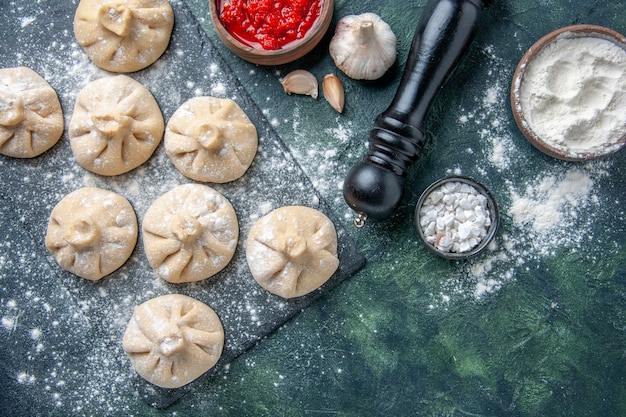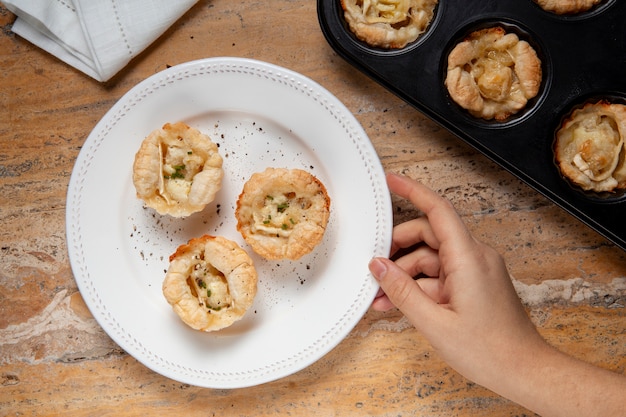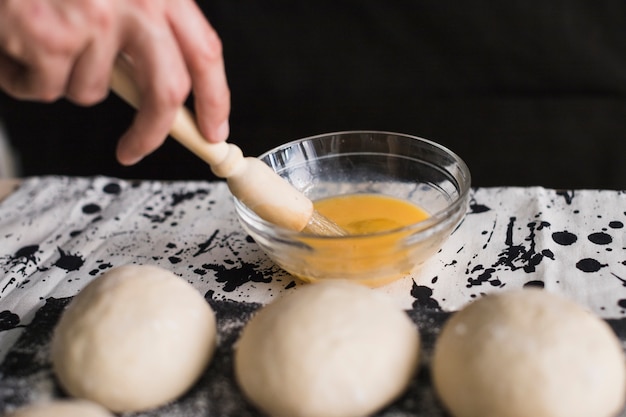The Magic of Pierogi: A culinary journey Through Time

There's a reason pierogi have been a staple in Eastern European cuisine for centuries. These versatile little dumplings offer a blank canvas for culinary creativity. Whether you're embracing the classic potato and cheese combo, venturing into the tangy world of sauerkraut, or adding a touch of sweetness with fruit fillings, there's a pierogi out there for every palate.
For me, though, the real magic of pierogi lies in the memories they evoke. Growing up, my kitchen was a symphony of laughter and aromas as we gathered around the table, crafting these little parcels of happiness. It's a tradition passed down through generations, a shared experience that brings families and friends closer. So, when I make pierogi, I'm not just creating a meal; I'm weaving together stories, preserving traditions, and celebrating the simple pleasures of good food and good company.
The Ingredients You'll Need: A Culinary Shopping List

Before we dive into the heart of our pierogi adventure, let's gather our supplies. Here's what you'll need to create a delicious batch of these Eastern European gems:
For the Dough:
- 4 cups all-purpose flour, plus extra for dusting. Choose a good quality flour – it's the foundation of our pierogi.
- 1 teaspoon salt. Just a touch of salt enhances the flavour of the dough.
- 1 egg, beaten. The egg adds richness and helps bind the dough together.
- 1 cup warm water. Warm water helps activate the yeast in the dough, contributing to its rise and texture.
For the Filling:
This is where you can really let your culinary creativity shine! Choose a favourite filling or experiment with a new flavour combination. For this recipe, we're going with a classic potato and cheese combo:
- 4 large potatoes, peeled and boiled. Choose potatoes that are starchy, like russet or Yukon Gold, for a creamy filling.
- 1/2 cup crumbled feta cheese. Feta adds a salty, tangy kick to the filling.
- 1/4 cup chopped fresh dill. Fresh dill adds a bright, herbaceous flavour that complements the potato and cheese.
- 1/4 cup chopped onion. A touch of onion adds a subtle sweetness and depth of flavour.
- Salt and black pepper to taste. Season generously to bring out the flavours of the filling.
For the Cooking:
- Large pot of salted water. The water should be generously salted to season the pierogi and create a flavorful broth.
- 1 tablespoon olive oil. A drizzle of olive oil prevents the pierogi from sticking together and adds a touch of richness.
- Butter or sour cream for serving (optional). These are classic accompaniments for pierogi, adding a touch of creaminess and flavour.
Creating the Perfect Dough: A Step-by-Step Guide to Culinary Success

The key to perfect pierogi lies in the dough. It should be smooth, elastic, and pliable enough to roll out without tearing. Here's how to create the perfect dough:
- In a large bowl, whisk together the flour and salt. This ensures the salt is evenly distributed throughout the dough.
- Make a well in the centre of the flour mixture. This will create a space for the wet ingredients.
- Add the beaten egg and warm water to the well. Gently incorporate the flour from the sides, using a fork or your fingertips. Don’t overmix the dough – just bring it together until it forms a cohesive ball.
- Once the dough starts to come together, transfer it to a lightly floured surface. This prevents it from sticking.
- Knead the dough for about 5-7 minutes, until it’s smooth and elastic. The kneading process develops the gluten in the dough, giving it its elasticity and chewiness.
- Place the dough in a lightly oiled bowl, cover it with plastic wrap, and let it rest for 30 minutes. This allows the gluten to relax, making the dough easier to work with.
Crafting the Filling: A Symphony of Flavours
Now let's get to the heart of our pierogi – the filling! While the dough is resting, create your delicious potato and cheese filling:
- While the dough is resting, boil the potatoes until tender. The potatoes should be fork-tender.
- Drain the potatoes and mash them thoroughly. Use a potato masher or a fork to create a smooth, creamy texture.
- In a separate bowl, combine the feta cheese, dill, and onion. This step allows you to combine the flavours and ensure they're evenly distributed in the filling.
- Add the cheese mixture to the mashed potatoes and stir well. Gently combine the ingredients to avoid over-mixing, which can make the filling too dense.
- Season with salt and pepper to taste. Taste the filling and adjust the seasoning as needed.
Forming the Pierogi: A Culinary Art
Get ready to unleash your inner artisan! This is where we transform our dough and filling into beautiful, filled pierogi.
- Divide the rested dough into 4 equal parts. This makes the rolling and cutting process manageable.
- Roll out each part on a lightly floured surface to about 1/8 inch thickness. Use a rolling pin to create a consistent thickness, ensuring the pierogi will cook evenly.
- Using a cookie cutter or a knife, cut out circles from the rolled-out dough. The size of your cutter will determine the size of your pierogi. A 3-4 inch cutter is a good starting point.
- Place a heaping teaspoon of the potato and cheese filling in the centre of each dough circle. Don't overfill the pierogi, or they may burst during cooking.
- Fold the dough circle in half and pinch the edges together to seal, creating a half-moon shape. This creates the classic pierogi shape.
- Use a fork to crimp the edges of each pierogi for a decorative touch. This step also ensures the edges are securely sealed.
Cooking the Pierogi: Bringing Them to Life
Alright, it's time to bring our little dumplings to life! Let's cook them to perfection:
- Bring a large pot of salted water to a boil. The water should be generously salted to season the pierogi and create a flavorful broth.
- Gently add the pierogi to the boiling water, making sure not to overcrowd the pot. Add the pierogi in batches to ensure they have enough room to cook evenly.
- Cook the pierogi for about 5-7 minutes, or until they float to the surface. This indicates that the pierogi are cooked through.
- Remove the cooked pierogi from the water using a slotted spoon and transfer them to a plate. Drain the pierogi thoroughly to prevent them from becoming soggy.
- Drizzle the pierogi with a tablespoon of olive oil to prevent them from sticking together. This keeps the pierogi moist and prevents them from clumping together.
Serving Up Perfection: A Culinary Masterpiece
And there you have it! You've successfully created a batch of homemade pierogi. But the real magic happens when you serve them up. Here's how I like to present my culinary masterpiece:
- Serve the pierogi warm, topped with a dollop of butter or sour cream. The warm pierogi, melted butter, and tangy sour cream create a delicious harmony of flavors and textures.
- A sprinkle of fresh dill or parsley adds a touch of elegance. A sprinkle of fresh herbs adds a burst of flavor and freshness.
- For a more decadent experience, try serving the pierogi with a side of caramelized onions or sauteed mushrooms. These savory toppings add another layer of complexity to the dish.
Variations on a Classic: Exploring New Flavour Horizons
The beauty of pierogi lies in their adaptability. Don’t be afraid to experiment with different fillings. Here are a few of my favourite variations:
Sweet and Savoury: A Culinary Fusion
- Blueberry Pierogi: Combine mashed blueberries with a touch of sugar and lemon zest for a sweet and tangy filling. The sweetness of the blueberries and the tang of the lemon zest create a perfect balance of flavors.
- Apple Cinnamon Pierogi: A classic pairing of apple and cinnamon, perfect for a cozy winter evening. The warm, comforting flavors of apple and cinnamon evoke feelings of warmth and nostalgia.
- Mushroom and Sauerkraut Pierogi: A flavour explosion of earthy mushrooms and tangy sauerkraut. This savory combination is a true delight for those who appreciate a little bit of tang and umami.
FAQs: Your Pierogi Questions Answered
Let's address some common questions about these delicious dumplings:
1. Can I freeze pierogi?
Absolutely! Frozen pierogi are a lifesaver when you need a quick and easy meal. Just freeze them in a single layer on a baking sheet and then transfer them to a freezer-safe bag. To cook them from frozen, simply drop them into boiling water and cook for a few extra minutes.
2. What are some other delicious toppings for pierogi?
Get creative! You can top your pierogi with anything you like. Some other popular options include: bacon bits, fried onions, roasted peppers, and even a drizzle of maple syrup for a sweet and savory twist.
3. How can I make my pierogi dough more elastic?
If your dough feels a bit sticky, try adding a little extra flour, a tablespoon at a time, until it reaches a smooth and elastic consistency. Be careful not to over-flour the dough, as it can become too dry.
4. Can I use store-bought pierogi dough?
Of course! If you're short on time or simply prefer not to make the dough from scratch, you can use store-bought pierogi dough. Just follow the instructions on the package.
5. What's the best way to store leftover pierogi?
Store leftover pierogi in an airtight container in the refrigerator for up to 3 days. You can also reheat them by steaming, boiling, or frying them.
A Final Bite: A Culinary Journey Continues
There you have it! My ultimate guide to making delicious homemade pierogi. I hope you’ve enjoyed this journey into the world of these delightful dumplings. Remember, the beauty of pierogi lies in their versatility and the joy of sharing them with loved ones. So, gather your ingredients, put on some music, and embrace the culinary adventure that awaits. Happy pierogi making!
And remember, while this recipe is a fantastic starting point, don't be afraid to experiment and make it your own. Add your own personal touch to the fillings, the dough, or the toppings. The most important thing is to have fun, enjoy the process, and create something delicious that you and your loved ones will cherish.
Everyone is watching

Corn on the Cob: The Ultimate Guide to Perfectly Cooked Ears
Healthy MealsAh, corn on the cob. Just the name evokes images of sunny days, barbecues, and that sweet, juicy flavour that ...

Perfect Pork Roast Oven Cooking Time: A Guide to Delicious Results
Healthy MealsThere's something truly satisfying about a perfectly roasted pork. The aroma alone is enough to make your mout...

Ham Cooking Time: How Long to Bake, Smoke, or Boil a Delicious Ham
Healthy MealsAh, ham. It's a classic, isn't it? A real crowd-pleaser, especially around holidays. And when done right, it'...

Scallops: The Ultimate Guide to Perfect Cooking
Healthy MealsAh, scallops. Those delicate, sweet, and utterly delicious morsels of the sea. They hold a special place in my...

Spaghetti Squash: The Ultimate Guide to Cooking and Serving
Healthy MealsRemember that time you saw spaghetti squash at the supermarket, looking all bumpy and strange, and thought, "W...
